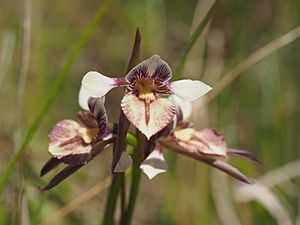Diuris eborensis facts for kids
Quick facts for kids Diuris eborensis |
|
|---|---|
 |
|
| Diuris eborensis growing near Ebor | |
| Conservation status | |
| Scientific classification | |
| Genus: |
Diuris
|
| Species: |
eborensis
|
Diuris eborensis is a special type of orchid that only grows in eastern Australia. It's often called a "donkey orchid" because its flowers can look a bit like a donkey's ears! This plant has long, thin leaves that look like grass. It also grows a tall stem with up to four pretty pale yellow flowers that have dark reddish-purple stripes.
Contents
What Does This Orchid Look Like?
Diuris eborensis is a plant that grows from a tuber (like a small potato underground). It comes back year after year. Each plant has about three to six leaves that look like grass. These leaves can be from 70 to 300 millimeters (about 3 to 12 inches) long and 3 to 6 millimeters (about 0.1 to 0.2 inches) wide.
The plant sends up a flowering stem that can be 150 to 350 millimeters (about 6 to 14 inches) tall. On this stem, you might see up to four flowers, each about 18 to 23 millimeters (about 0.7 to 0.9 inches) wide. The flowers are a pale yellow with dark reddish-purple stripes and lines. They often lean a little bit forward.
- The top part of the flower, called the dorsal sepal, is 8 to 12 millimeters (about 0.3 to 0.5 inches) long. It points upwards.
- The two side parts, called lateral sepals, are longer, about 15 to 20 millimeters (about 0.6 to 0.8 inches) long. They turn slightly downwards.
- The petals look like small ears on the sides of the flower. They are 6 to 9 millimeters (about 0.2 to 0.4 inches) long.
- The labellum is the special "lip" of the orchid flower. It is 11 to 14 millimeters (about 0.4 to 0.6 inches) long and has three parts. The middle part is shaped like a wide egg.
- The edges of the labellum are wavy, like scallops. There are also two small bumps and a thin ridge in the middle of the labellum.
This orchid usually blooms from October to early December. After the flowers, the plant produces a seed pod, called a capsule. This capsule can hold up to 500 tiny seeds!
How Did It Get Its Name?
Scientists give every plant and animal a special two-part name. This helps everyone around the world know exactly which species they are talking about. The Diuris eborensis orchid was officially named in 2006 by a botanist named David Jones. He wrote about it in a science book called Australian Orchid Research. The plant was first found near a place called Rigney Creek, which is west of Ebor. That's where the "eborensis" part of its name comes from!
Where Does This Orchid Live?
This special donkey orchid likes to grow in wet, grassy areas. You can find it near streams in five different spots on the New England Tableland in Australia. It needs these specific conditions to grow and thrive.
Why Is This Orchid Endangered?
Sadly, Diuris eborensis is an "endangered" species. This means there are not many of these plants left in the wild, and they are at risk of disappearing forever. In New South Wales, Australia, there's a law called the Threatened Species Conservation Act 1995 that lists it as endangered. The Australian Government has also suggested it be listed as endangered under their Environment Protection and Biodiversity Conservation Act 1999.
There are several reasons why this orchid is in danger:
- Grazing Animals: Cows and other farm animals sometimes eat or step on the plants.
- Weeds: Other plants, called weeds, can grow quickly and take over the space, making it hard for the orchids to get enough sunlight and nutrients.
- Human Activities: Things like camping, building roads, and people dumping trash can also harm the places where these orchids grow.
Protecting these special places is very important to help Diuris eborensis survive.
Images for kids



